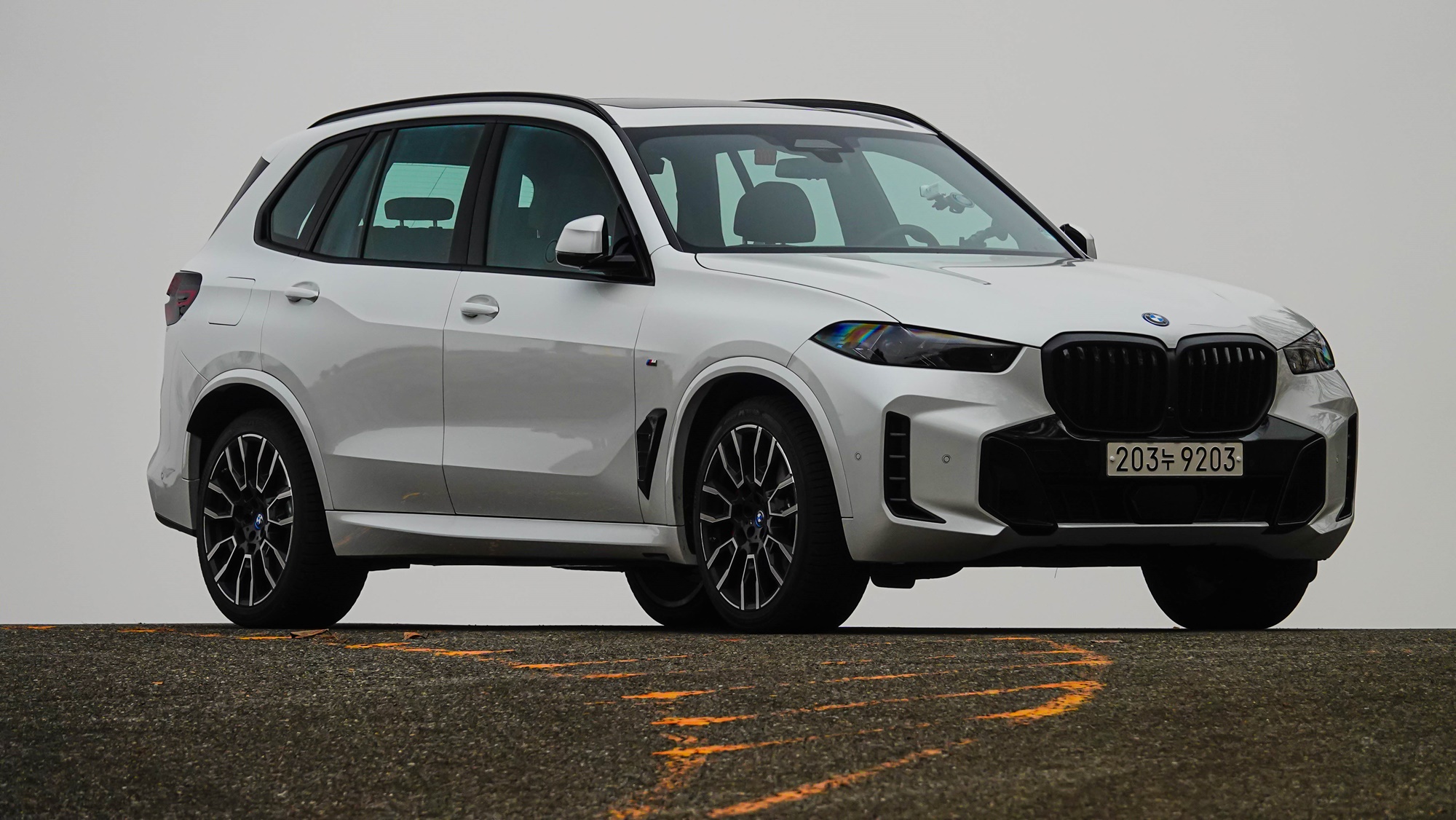
This feather-light weight totals a remarkable 2.5 tons, showcasing its impressive power. Efficiency is also exceptional. We drove 55km solely on electric power from Heyri Village to Seocho-dong Gyodae Station. Although it’s a plug-in hybrid vehicle, it can easily function just as an electric vehicle without needing the engine. This is the new BMW X5 xDrive 50e.
It features the iconic glow with lighting in the radiator grille. The headlights have been slimmed down. The angel eyes, once the trademark of BMW’s headlights, are now nearly impossible to find. It’s a gradual transformation.

The curved display consists of a 12.3-inch instrument cluster and a 14.9-inch control display. Physical buttons have been minimized, and adjustments are made through a touchscreen interface. The newly designed gear selector shines like a jewel.
The most complex powertrain in a car is the plug-in hybrid system. It includes an engine, motor, and charging system. Remove the engine, and it’s an electric vehicle; remove the motor, and it’s a gasoline vehicle.
It features air suspension, allowing for height adjustment of the vehicle. Thanks to this, ride comfort and driving stability are superb.

The inline 6-cylinder 3.0 TwinPower Turbo gasoline engine produces 313 horsepower. The electric motor generates 197 horsepower. The combined output totals 489 horsepower, a gain of 95 horsepower compared to the previous model, nearly 100 more.
Weight is as crucial as power. The vehicle’s curb weight is 2,555kg. It has gained some weight due to additional features, but the 489 horsepower feels more than ample to almost negate that weight. The power-to-weight ratio is 5.2kg per horsepower. With this, it can reach 100 km/h in about 5 seconds. The official specification states 4.8 seconds, while our GPS measurement clocked it at 5.2 seconds to hit that speed.

At speeds around 100 km/h, it provides exceptional ride comfort. The suspension is firm yet never harsh in response. It feels like a solid fist wrapped in a resilient glove. This interplay of firmness and softness continually enhances stability. This, combined with the 21-inch tires, air suspension, and all-wheel-drive system, yields great results. Additionally, the weight of 2.5 tons pressing down on the chassis isn’t unfavorable either.
Despite being an eco-friendly vehicle, BMW never compromises the joy of driving. The driving experience is dynamic and sometimes exhilarating. It’s still quintessentially BMW.

The Driving Assistant Professional implements lane change assistance. It monitors not just your lane but two adjacent lanes, maintaining distance and smoothly navigating lane changes when necessary. At the Level 2 autonomy level, this represents top-notch performance.

It can even handle parking for you. By recording the driving trajectory, it can replicate that path when you return, smoothly completing the parking maneuver. Options for both forward and backward parking are available. Once selected, the car takes care of steering and shifting into drive/reverse; all you need to do is sit back. Occasionally, a gentle tap on the brakes is all that’s required. The driver can also step outside and control the vehicle via a smartphone app. BMW is gradually proving through the X5 that we are on the path to a true autonomous driving age.

The lithium-ion battery has a capacity of 29.5 kWh, a 25% increase from before. The maximum electric driving range on a single charge is 77 km. Given that we traveled 55 km from Heyri to Gyodae Station with the battery at roughly half capacity, it’s conceivable that it could go even further. However, this cannot be definitively stated, as weather variables play a crucial role. Cold temperatures can significantly decrease battery efficiency.

The electric driving can reach speeds of up to 140 km/h. We confirmed that the motor could provide power even exceeding 100 km/h. It can be used entirely as an electric vehicle. Regularly charging it while using it as an EV represents the ideal approach to owning a plug-in hybrid. The engine’s fuel efficiency is 9.4 km/L. Considering the engine size, vehicle class, and weight, this is commendable efficiency. Yet, using the electric motor first is the most rational choice.
The new X5 comes with several options. The new X5 xDrive 30d starts at 117 million KRW, while the new X5 xDrive 50e ranges from 128.2 million to 135.2 million KRW. The new X5 M60i xDrive costs 158 million KRW.

– Oh Jong-hoon’s Straight Talk
Another drawback of the X5 equipped with the best specifications is the absence of laser lights. This flagship option for the headlamps is emblematic and unavailable, which is disappointing. The trunk is positioned high due to the high-voltage battery underneath, which is understandable but still disheartening. While the suspension can be adjusted slightly lower, it still leaves something to be desired.
Contact: Oh Jong-hoon yes@autodiary.kr

